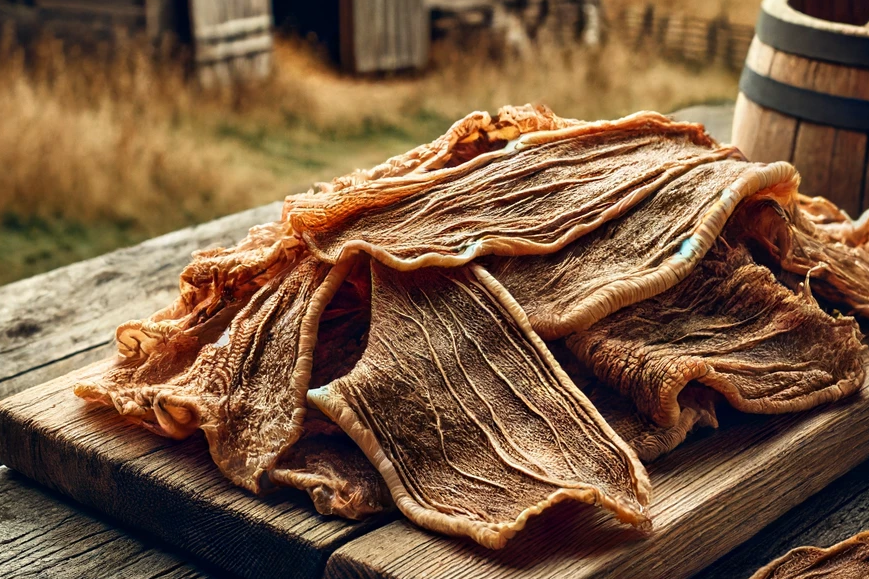Lamb skin

Lamb skin is a popular chew for dogs that offers many benefits for the health and well-being of your four-legged friend. In this article, you will find out what lambskin is, how it is made, its advantages and disadvantages and what you should look out for when buying it.
What is lamb skin?
Lamb skin is the dried skin of lambs, which is a by-product of meat production. It is usually gently dried without unnecessary additives such as preservatives, colorants or flavor enhancers in order to preserve its natural taste and nutrients. Lamb skin is a 100% natural dried meat that is rich in protein, fat and minerals such as calcium and phosphorus.
How is lamb skin made?
The production of lamb skin is relatively simple and involves several steps:
- The fresh skin is obtained from the abattoirs and thoroughly cleaned.
- The skin is cut into strips, which can vary in length, thickness and shape depending on the product.
- The strips are dried in special drying facilities at low temperatures to reduce moisture and increase shelf life.
- The dried strips are packaged and shipped.
Some products are additionally refined with other ingredients such as honey or herbs or preserved by smoking. This can change the taste, smell and color of the lamb skin.
What are the benefits of lamb skin for dogs?
Lamb skin has many benefits for dogs, promoting both physical and mental health:
- Lamb skin is a tasty chew that satisfies your dog's natural chewing instinct and provides them with a meaningful activity.
- Lamb skin strengthens your dog's chewing muscles and therefore contributes to better oral hygiene. Chewing removes food debris and reduces plaque, which reduces the risk of tartar build-up, gingivitis and bad breath.
- Lamb skin is very easy to digest and is also suitable for dogs and puppies with allergies. It contains no grain or other common allergens such as beef or pork and is therefore a hypoallergenic alternative to other chews.
- Lamb skin provides your dog with important nutrients such as protein, fat and minerals, which are important for a healthy coat, strong bones and a good immune system.
What are the disadvantages of lamb skin for dogs?
Lamb skin also has some disadvantages for dogs that you should be aware of:
- Lamb skin can have a high fat content, which can range from 20% to 40% depending on the product. This can lead to obesity, digestive problems or pancreatitis if your dog eats too much of it or suffers from a fat intolerance. Therefore, make sure that the dosage is appropriate and reduce the amount of normal food if necessary.
- Lamb skin can contain parasites or bacteria that are not killed if not stored or processed properly. This can lead to infections or gastrointestinal problems if your dog eats the lamb skin. Therefore, make sure that the products are of high quality and hygienically packaged and store them in a cool, dry place.
- Lamb skin cannot guarantee the origin of the lambs used for production. This can raise ethical concerns if you value animal welfare and environmental friendliness. Therefore, make sure that the products are labeled transparently and, if necessary, choose organic quality, which promises a certain level of animal welfare and sustainability.
What should you look out for when buying lamb skin for dogs?
If you want to buy lamb skin for your dog, you should pay attention to a few criteria to ensure good quality and safe use:
- The composition: make sure that the lamb skin is as natural as possible and does not contain any unnecessary additives such as preservatives, colorants or flavor enhancers. These can affect your dog's health or trigger allergies. If the lamb skin is refined or smoked with other ingredients, check whether these are compatible with your dog.
- The origin: Make sure that the lamb skin comes from a trustworthy source and has a clear indication of origin. This can give you information about the quality, freshness and safety of the products. If you value animal welfare and environmental friendliness, choose organic quality that promises a certain level of animal welfare and sustainability.
- The size: Make sure that the lamb skin is the right size for your dog. This can affect chewing time, taste and the risk of choking or suffocation. Choose between short, long, thin or thick strips depending on your dog's size and preference.
- The amount: Make sure you don't give your dog too much lamb skin. This can lead to obesity, digestive problems or pancreatitis if your dog consumes too much fat or has a fat intolerance. Only give your dog as much lamb skin as he can eat in one sitting and reduce the amount of normal food if necessary.
Lamb skin is a healthy and tasty chew for dogs that offers many benefits for the health and well-being of your four-legged friend. It strengthens the chewing muscles, promotes oral hygiene, is easy to digest and provides your dog with important nutrients. It is also suitable for dogs with allergies and puppies. However, you should also be aware of some disadvantages, such as the high fat content, the risk of parasites or bacteria or the ethical concerns regarding the origin of the lambs. Therefore, make sure that the dosage is appropriate, the quality is high and the labeling of the products is transparent. If you follow these tips, you can offer your dog a meaningful activity and a tasty reward.
If you notice any signs of hypersensitivity or poisoning in your dog, you should see your vet immediately. We are not a substitute for a vet, but we try to be as accurate as possible. Every dog reacts differently and we recommend you get a second opinion or consult your vet if in doubt.
Stay healthy and take good care of your four-legged friend!😊
Similar to Lamb skin
Fish skin is the outer layer of fish that protects them from injuries and pathogens. It consists of scales that vary in size and shape depending on the fish species. Fish skin contains many valuable...
Poultry skin is the thin layer of fat and connective tissue that covers the meat of chickens, turkeys, ducks or geese. It is often crispy and aromatic and is eaten by many people. But is it also...
Rabbit skin with fur is, as the name suggests, the skin of a rabbit with the fur on. It is a by-product of rabbit breeding that is normally disposed of. For dogs, however, it is a valuable...
Sheepskin is exactly what the name suggests: the skin of sheep that is collected after slaughter, cleaned and often dried to serve as a chew for dogs. It is considered a natural, unprocessed...



